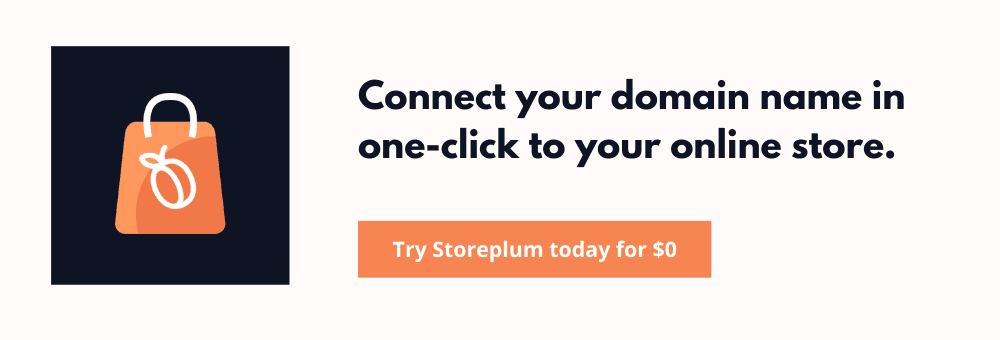How to Secure a Domain Name: Essential Dos and Don'ts

By Storeplum Editorial
Posted | 14 min read
Table of contents
- Introduction
- Do: Choose a reputable domain registrar
- Don't: Neglect domain privacy and WHOIS protection
- Do: Implement domain locking and security features
- Don't: Overlook domain expiration and renewal
- Do: Protect your brand with additional domain registrations
- Don't: Transfer domain names without caution
- Do: Seek professional help when needed
Introduction
A domain name should not just be easier to remember, it should help build trust with website visitors and help in generating website traffic and overall search engine rankings.
A primary domain name is the address for your website whereas secure domain names begin with "https://" instead of "http://", and they come with an SSL certificate that encrypts data exchanged between your website and its visitors.
This encryption prevents any third party from accessing the information shared on your company’s domain, ensuring the confidentiality and integrity of user data.
Business owners prefer to go with a more secure domain name which not only help them with website’s privacy but also with overall seo.
A secure domain name can protect the website website from hacking attempts and cyber threats.
This is especially important for ecommerce websites that deal with sensitive customer information such as credit card details.
In this blog post, we will provide an overview of key dos and don'ts for securing a domain name. We will explore best practices for choosing and registering a domain name, as well as important considerations for maintaining its security over time.
By following these key dos and don'ts for securing a domain name, you can help ensure that your online presence is secure and protected against potential threats. So, let’s get started!
Do: Choose a reputable domain registrar
1. Research and compare domain registrars
Before you register the domain, researching and comparing different registrars can help ensure that you're working with a reputable and reliable company.
First and foremost, consider the domain name registrar and it’s reputation.
Look for reviews from other customers and check if they have any history of security breaches or downtime.
Pricing is also an important factor, as some registrars may offer lower prices or discounts for longer registration periods.
However, beware of registrars that offer prices that are too good to be true, as they may have hidden fees or offer poor customer service.
Also those who offer domain names like names that are extremely similar to another company.
Another important consideration is customer support.
Make sure that the registrar offers 24/7 support in case you encounter any issues with your domain name or account.
Look for registrars that offer multiple support channels such as phone, email, and chat to ensure that you can get help when you need it.
2. Understand the domain registration process and related terms
When selecting a domain registrar, it's essential to consider not only the pricing but also the features and services they offer.
Reputable domain registrars often provide additional features such as DNS management, domain privacy protection, and website hosting, which can simplify your website management process.
Before choosing a domain registrar, take some time to research and compare different options based on their reputation, pricing, and customer support.
Look for reviews and feedback from other users to gain insight into their experiences with the registrar.
You can also check if the registrar is accredited by the Internet Corporation for Assigned Names and Numbers (ICANN), which is the organization responsible for managing domain names and IP addresses.
Understanding the domain registration process and related terms is also crucial when selecting a registrar.
You should be familiar with terms like domain transfer, registry lock, domain renewal, and domain expiration to avoid any issues in the future.
Moreover, ensure that the registrar has secure systems and protocols in place to protect your domain and website from cyber threats.
3. Consider additional features and services provided by the registrar
In addition to the basic domain registration services, many registrars offer additional features and services that can help enhance the security and functionality of your domain name.
Some of the features and services to consider when choosing a registrar include easy access to your domain web address, domain privacy protection, DNS management tools, email hosting, and website builder tools.
Domain privacy protection can help keep your personal information private and protect you from spam and other unsolicited communications.
DNS management tools can help you easily manage your domain name and configure DNS settings.
Email hosting and website builder tools can also help streamline your online presence and provide a more professional image.
It's important to do your research and compare the features and services provided by different registrars before making a decision.
By choosing a registrar that offers the additional features and services that are important to you, you can help ensure that your domain name is secure, functional, and able to support your online goals.
Don't: Neglect domain privacy and WHOIS protection
WHOIS is a public database that contains information about registered domain names, including the name and contact details of the registrant, the registrar, and the registration and expiration dates.
While this information is publicly accessible, it can also leave your website vulnerable to cyber attacks or spam emails.
To protect your personal information and keep the domain name safe, many domain registrars offer privacy protection services that replace your WHOIS details with the registrar's information.
This way, your contact information is kept private and is not exposed to the public and you can secure your domain name and personal data.
Benefits of domain privacy protection
When you register a domain name, your personal information such as name, address, email, and phone number is recorded in the WHOIS database, which is publicly accessible.
This means that your personal details are exposed to hacker, spammers, scammers, and marketers who can use it for targeted advertising or phishing attempts.
Domain privacy protection services provide a solution to this problem by masking your personal information with generic contact details, making it harder for anyone to access your personal information.
This not only helps to protect your privacy but also prevents domain hijacking attempts and other malicious activities that can harm your online reputation.
Enabling domain privacy
To enable domain privacy protection, you can opt-in during the domain registration process or through your registrar's control panel.
Some registrars offer this service for free, while others charge a fee. When choosing a registrar, consider their privacy protection policies and fees to ensure you select a reputable provider.
Do: Implement domain locking and security features
1. Domain locking activation
To activate domain locking, you can typically do so through your domain registrar's control panel or dashboard.
Look for a setting related to domain locking or transfer protection.
Once enabled, your domain name will be protected from any unauthorized attempts to transfer it to another registrar.
This feature prevents anyone from transferring your domain name to another registrar without your authorization.
It essentially puts a lock on your domain name to keep it secure.
2. Enable 2FA and other authentication mechanisms
One way to enhance your domain security is by utilizing additional security features provided by your registrar, such as two-factor authentication or account notifications.
Two-factor authentication requires you to enter a unique code sent to your registered mobile device or email to access your account.
This adds an extra layer of security beyond just a username and password.
Account notifications, on the other hand, alert you via email or text message when any changes or updates are made to your account or domain.
By monitoring these notifications, you can quickly identify any unauthorized changes and take corrective action.
3. Keep your account and contact information up-to-date and secure
When you keep your account and contact information up-to-date, it helps prevent potential fraudulent activities, such as domain theft or unauthorized transfer attempts.
Make sure to use a strong and unique password for your account, and consider enabling two-factor authentication for an extra layer of security.
Regularly review your account activity and monitor any unauthorized access or suspicious activity.
This can help prevent potential security vulnerabilities that could be exploited by malicious actors.
Don't: Overlook domain expiration and renewal
When a domain name expires, it becomes available for registration to anyone, which could lead to website downtime or even domain hijacking.
This means you loose the control over your domain name before it expires which could present a bad image in front of website users.
To avoid these issues where you forget to renew, it is important to keep your domain registration up-to-date and renew it before it expires.
1. Automatic domain renewals
When a domain expires, it can cause website downtime, which can negatively impact your business or personal brand.
Moreover, expired domains can also be subject to hijacking or purchase by third-party individuals or entities, which can lead to reputational damage and loss of control over your online identity.
Many domain registrars offer automatic renewal options that can be set up during the initial registration or through the account control panel.
Additionally, setting up calendar reminders can help ensure that you don't miss any renewal deadlines.
This way when you turn on auto-renew feature, you’ll have a grace period where you’ll get time to renew your domain name.
2. Monitor multiple domains and their expiration dates to avoid lapses
One of the biggest risks associated with domain names is letting them expire without realizing it.
This can result in your website going down and potentially even losing your domain name to a competitor or domain squatter. Monitoring multiple domains helps to prevent such a scenario.
To avoid this scenario, it's essential to monitor multiple domains and their expiration dates.
This involves regularly checking when each domain is set to expire and taking action before the expiration date arrives.
Do: Protect your brand with additional domain registrations
One strategy to address this challenge is to register variations and common misspellings of your domain name.
This not only ensures that you own all potential versions of your domain name, but it also protects you against competitors or malicious actors who might try to exploit these variations.
When you register your domain name you can see which domain name is available and register some additional ones as well.
For example, if your domain name is “mybrand .com”, you may want to consider registering “mybrand. net”, “mybrands .com”, and “mybrandd .com”. By doing so, you can prevent others from registering similar domain names that could potentially divert traffic away from your website.
Look into top level domains for your brand name and buy related domain names for your business.
1. How to prevent cybersquatting and brand dilution
Cybersquatting is the practice of registering, trafficking in, or using a domain name that is identical or confusingly similar to a trademark or service mark owned by someone else.
Typosquatting is a form of cybersquatting where an individual or a company registers domain names that are similar to popular or commonly visited websites, but with slight variations or misspellings.
For example, a typosquatter might register a domain name like "gogle .com" instead of "google .com", with the hope that users who accidentally type "gogle .com" will be redirected to their website instead of the intended website.
By owning more domain names related to your brand, you can prevent such an event from happening as well as prevent brand dilution.
This part helps a lot in domain protection and helps secure your website domain from such cybersquatters.
2. Monitor and address trademark infringements
Registering a domain name that's similar to an existing trademark can lead to legal issues and damage your brand's reputation.
As such, it's crucial to monitor and address any potential infringements proactively.
One way to do this is to conduct regular trademark searches to ensure that your domain name and branding do not infringe on any existing trademarks.
It's also wise to consult with a legal professional who can help you navigate the complex world of trademarks and intellectual property.
Don't: Transfer domain names without caution
If you are considering a domain transfer or want to sell your domain, it's important to understand the requirements and process to avoid any disruptions to your online presence.
For example, you’ve had a domain name for 10 years and now you’d like to sell it so you can transfer that domain from one entity to another.
First, ensure that your domain is eligible for transfer by checking its status and expiration date.
Additionally, make sure that your domain is not locked, suspended, or under a 60-day transfer lock following a recent registration or transfer.
Next, obtain an authorization code, also known as an EPP code, from your current registrar to initiate the transfer process.
You will also need to provide accurate and up-to-date contact information, including your email address and administrative contact.
Once the transfer is initiated, the new registrar will send an email notification to the administrative contact to confirm the transfer request.
You will need to approve the request within a specified timeframe to proceed with the transfer.
Finally, ensure that your domain transfer is completed successfully by monitoring your domain's status and updating your DNS settings if necessary.
Choosing a reputable receiving registrar
When it comes to transferring your domain to a new registrar, it's important to choose a reputable receiving registrar that can handle the process smoothly.
Look for a registrar with a good track record of successful transfers, positive reviews, and excellent customer support.
Once you've selected your new registrar, make sure to follow the transfer process carefully.
This typically involves obtaining an authorization code or transfer key from your current registrar and unlocking your domain name.
You may also need to verify your contact information and approve the transfer request.
During the transfer process, it's crucial to maintain consistent communication with both your current and receiving registrars to ensure a smooth transition.
This can help minimize any downtime or disruption to your website or email services.
Do: Seek professional help when needed
While you may be able to handle minor issues of domain for the longest amount of time on your own, it's essential to recognize when it's time to seek help from domain name experts or legal advisors.
Hosting companies with top-level domains like godaddy can walk you through the process and provide with brandable domain name, this removes unsecured options and does authenticate the process. Legal advisors can assist with trademark and intellectual property issues related to your domain name.
They can also help you navigate the legal landscape if someone is infringing on your domain name or if you receive a cease-and-desist letter.
Domain name experts can provide guidance on technical issues such as domain name system (DNS) configurations, security protocols, and optimization.
They may also have experience handling disputes over domain ownership or negotiating the purchase or sale of domain names.
One way is to use dnssec, it uses cryptographic techniques to ensure the authenticity and integrity of DNS data, helping to prevent DNS spoofing attacks and other types of DNS-related security threats.
Address domain-related disputes through appropriate channels
If you're facing a domain-related issue, the first step is to try to resolve it amicably with the other party.
This can involve negotiating a resolution or reaching a compromise that satisfies both parties. However, if a resolution cannot be reached, it may be necessary to engage legal counsel or domain name experts to help mediate the dispute.
In some cases, disputes can be resolved through alternative dispute resolution (ADR) mechanisms such as the Uniform Domain Name Dispute Resolution Policy (UDRP) or the World Intellectual Property Organization (WIPO) mediation and arbitration services.
These processes can provide a quicker and less costly resolution than traditional litigation.
Stay informed about domain security best practices and industry news
The world of domain security is constantly evolving, and it can be challenging to keep up with the latest best practices and industry news.
To stay informed and up-to-date, it's important to make a habit of regularly reading relevant blogs, forums, and news sources.
You can also attend industry events and conferences, where you can learn from experts in the field and network with other professionals.
Joining online communities and forums can also be a great way to stay informed and share knowledge with others.
Conclusion
Just having an easy to remember domain name could make the mistake.
Domain names are a valuable assets for every registered owner so they need to play the part too. You can also go for tlds to have a great seo exposure and grow your business immensely.
By following these dos and don'ts, you can ensure your domain is secure and avoid potential issues or disputes.
It's also essential to stay informed about domain security best practices and industry news to keep up with any changes or updates.
Protecting your domain name is not just good practice, but also essential for the long-term success of your online business or personal brand.
How do I protect my domain name?
To protect your domain name, make sure you keep your contact information up-to-date, use domain privacy to hide your personal information from the public, and consider trademarking your domain name if it's connected to your business or brand.
What happens if my domain name expires?
If your domain name expires, you may lose ownership over that name. However, some registrars offer an auto-renewal option to keep your domain name registered.
Should I renew my domain name?
Yes, it's important to renew your domain name to ensure that you maintain ownership over that name. Set up auto-renewal or mark your renewal date so you don't forget to renew.
How do I secure my domain name?
To secure your domain name, make sure that you have access to your domain and keep your contact information up-to-date. You can also use a secure password and two-factor authentication to protect your account from hackers.

Storeplum's in-house editorial team brings to you the best content when it comes to growing your online business on the Internet. We write about growth hacks, case studies, government schemes and other related information for e-commerce business.





